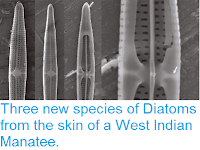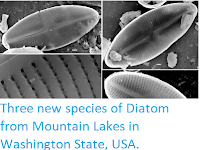Diatoms are single celled algae related to Kelp and Water Moulds. They are encased in silica shells with two valves. During reproduction the cells divide in two, each of which retains one valve of the shell, growing a new opposing valve, which is slightly smaller and fits flush within the older valve. This means that the Diatoms grow smaller with each new generation, until they reach a minimum size, when they undergo a phase of sexual reproduction, giving rise to a new generation of full-sized cells. The genus Pseudo-nitzschia currently contains 49 described species with an apparent global distribution. Of these species, 24 have been shown to produce domoic acid, a potent neurotoxin which can accumulate in the marine food webs, with potential harmful consequences for both Humans and marine life, and it is likely that other species, perhaps all members of the genus, will produce this toxin under the right circumstances. For this reason, monitoring for these Diatoms forms a part of many seafood safety programs around the world.
In a paper published in the journal PLoS One on 12 April 2018, Penelope Ajani and Arjun Verma of the Climate Change Cluster at the University of Technology Sydney, Malwenn Lassudrie, also of the Climate Change Cluster at the University of Technology Sydney, and of the Station de Biologie Marine de Concarneau, and Martina Doblin and Shauna Murray, again of the Climate Change Cluster at the University of Technology Sydney, describe a new species of Pseudo-nitzschia from the East Australian Current.
The new species is named Pseudo-nitzschia hallegraeffii, in honour of Gustaaf Hallegraeff of the University of Tasmania, for his work on toxic Algae, and in particular those of Australia. The species was isolated from samples collected by the Commonwealth Scientific and Industrial Research Organisation’s ship, the Research Vessel Investigator, during a voyage in September 2016, which studied the interplay between the East Australian Current, which brings cool waters from the south up the eastern coast of Australia, and the Western Boundary Current, which brings warm waters from the Coral Sea to the same region. The species was identified as a separate species by microscopic examination of the cells, DNA analysis, and attempts to breed the Algae with other members of the same genus.
Map of the East Australian Current as shown travelling south along the south-eastern Australian coastline and indicated by the warm sea-surface temperature. The location where the specimens from which Pseudo-nitzschia hallegraeffii is described were collected is shown by black star. Sea surface data was compiled using the average highest available quality sea surface temperatures data from 12 to 17 September 2016 and eastward geostrophic current velocity data of 17 September 2016. Ajani et al. (2018).
Cells of Pseudo-nitzschia hallegraeffii range from 25.6 to 55.4 μm in length and from 1.9 to 3.1 μm in width, and are lance shaped, with a large interspace towards the centre of each cell. The species was not found to produce domoic acid.
Pseudo-nitzschia hallegraeffii. (A)-(F) transmission electron microscopy; (A) whole valves, scale bar 10 μm; (B) mid-valves showing large central interspace, scale bar 1 μm; (C) mid-valve showing interstriae, fibulae and two rows of poroids, scale bar 1 μm; (D) valve end, scale bar 0.5 μm; (E) cingulum girdle bands: V = valvocopula, II = second copula, III = third copula, scale bar 1 μm; (F) valvocopula showing poroid structure of two poroids wide and one or two poroids high, scale bar 1 μm. Ajani et al. (2018).
See also...
Follow Sciency Thoughts on Facebook.








